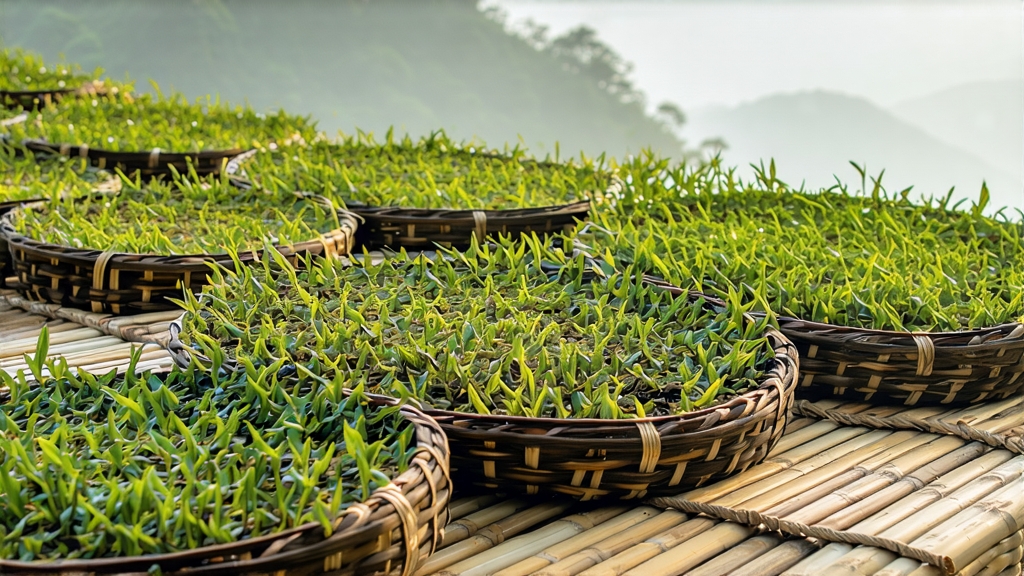
Tucked away in the cloud-veiled peaks of Sichuan’s Meng Ding Shan, Meng Ding Huang Ya—literally “Meng Ding Yellow Bud”—is the quiet aristocrat of Chinese tea. While green teas grab export headlines and pu-erhs age into investment portfolios, this yellow tea survives in a narrow ecological and cultural niche, its production so small that even within China most drinkers know it only from textbooks. Yet for more than twelve centuries the tiny golden buds were carried by fast horses to the Tang, Song and Ming courts, earning the mountain the nickname “The Royal Tea Nursery of China.” Today only a few hundred families still master the slow “sealed yellowing” technique that turns a spring green bud into a honey-amber liquor, making every sip a taste of endangered heritage.
History: from imperial tribute to near extinction
The first written record appears in the Tang dynasty compendium Meng Xi Bi Tan (1086 CE), which lists “Meng Ding Huang” among the fourteen tribute teas demanded by the emperor. During the Song, Buddhist monks on the mountain refined the withering and “men huang” (sealed yellowing) steps to satisfy the court’s growing obsession with pale, sweet infusions. Tribute quotas peaked in 1391 when the Hongwu Emperor exempted Meng Ding from land tax in exchange for 350 kilograms of buds. Caravan routes radiated from Ya’an—the starting point of the Tibetan tea road—so Huang Ya traveled both to Beijing and Lhasa, bridging Han and Tibetan cultures.
The 19th century brought turmoil: the Taiping Rebellion cut trade routes, and British Indian teas flooded markets. By 1949 fewer than five households still knew the full yellowing protocol. Revival began in 1958 when the Sichuan Tea Research Institute tracked down 83-year-old master Zhang Zhi-xian, who demonstrated the exact pile-turning rhythm he learned as an apprentice in 1890. State farms planted 120 mu (8 hectares) of the old shrub line, yet even now annual yield hovers around 2.5 metric tons, 70 % of which is pre-sold to collectors in Chengdu and Tokyo.
Cultivar and terroir
Meng Ding Huang Ya is made exclusively from a local micro-species of Camellia sinensis var. sinensis nicknamed “Gan Cha” (sweet tea bush). Growing between 800 m and 1400 m on shaded, moss-covered terraces, the bushes absorb 30 % less ultraviolet than valley plants, yielding buds unusually high in theanine and low in catechins—chemistry that later enables the mellow “yellow” character. Spring fog keeps humidity above 85 %, so leaves remain tender for weeks; the average bud set is only 2.3 cm long, half the size of a Longjing sparrow’s tongue. Picking window opens around Qingming (early April) and closes before Grain Rain, giving farmers barely twenty days to collect the 42 000 buds required for one kilogram of finished tea.
Craft: the art of “sealed yellowing”
Unlike green tea, which is quickly pan-fired to lock in verdant hues, Huang Ya must be coaxed into oxidation limbo—neither green nor black. The process unfolds in five meticulous stages:
- Fixing (sha qing): buds are tossed in bamboo drums heated to 140 °C for 90 seconds, just enough to denature polyphenol oxidase at the surface while leaving inner enzymes alive.
- Pre-roll & primary dry: the leaves are gently rolled for 8 minutes, then baked at 80 °C until 55 % moisture remains.
- Sealed yellowing (men huang): the critical step. The semi-dry leaf is wrapped in thick yellow cotton paper and stacked in bamboo steamers. Over 48–72 hours the pile is turned every 6 hours; internal temperature climbs to 38 °C, re-activating residual enzymes that convert chlorophyll into pheophytin and catechins into theaflavins, tinting the leaf ochre-gold and creating a baked sweet-corn aroma.
- Re-roll & low bake: leaves are loosened, re-rolled to tighten the strip, then dried at 60 °C to 8 % moisture.
- Aging rest: finished tea is stored in unsealed earthen jars for 10–15 days so the “fire” dissipates and the signature honey note stabilizes.
The entire cycle takes seven days, three times longer than typical green tea, and demands constant sensory vigilance: a mis